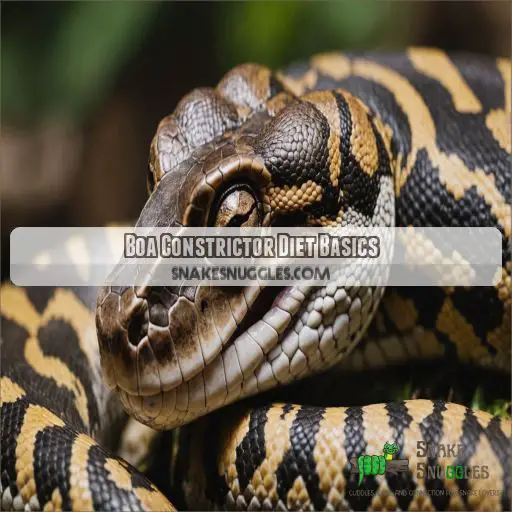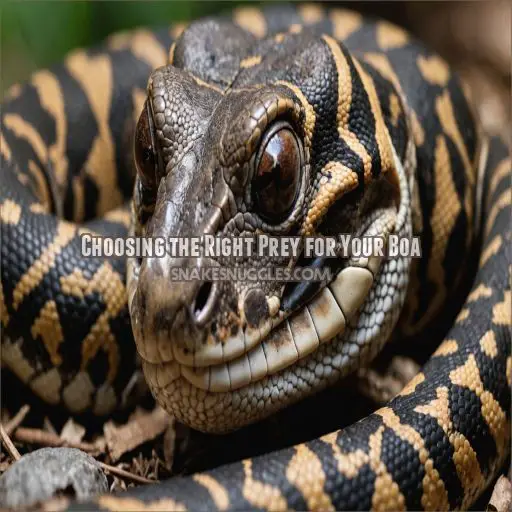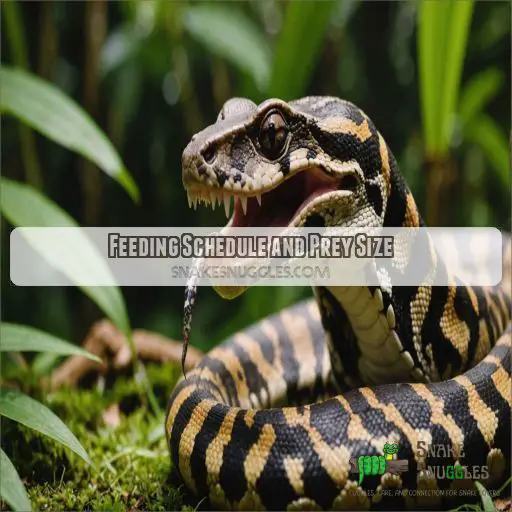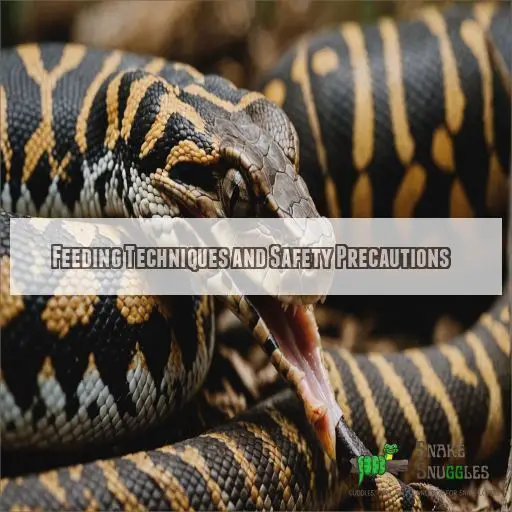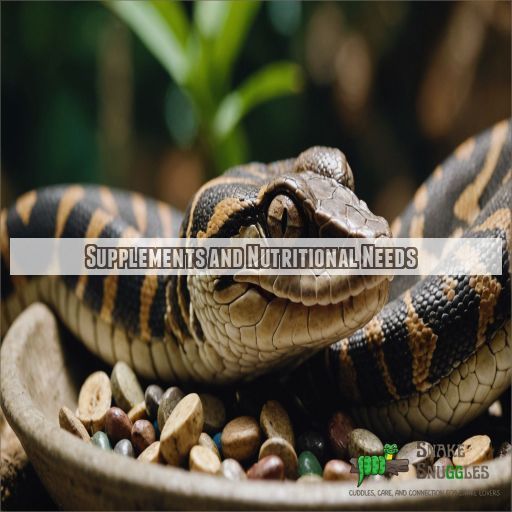This site is supported by our readers. We may earn a commission, at no cost to you, if you purchase through links.

These sneaky serpents love feasting on a smorgasbord of whole prey like mice, rats, and birds.
Boas are the ultimate dinner party guests, never saying no to a bone-in option, as fur and feathers provide essential nutrients.
Unlike your appetite at a buffet, their feeding habits aren’t daily; they adjust based on availability.
In captivity, serve them thawed, pre-sized prey for good health.
Curious about the perfect boa menu? Read on!
Table Of Contents
- Key Takeaways
- Boa Constrictor Diet Basics
- Choosing the Right Prey for Your Boa
- Feeding Schedule and Prey Size
- Feeding Techniques and Safety Precautions
- Supplements and Nutritional Needs
- Frequently Asked Questions (FAQs)
- What do boa constrictors like to eat?
- What can I feed my boa constrictor?
- How often does a boa constrictor eat?
- How big of an animal can a boa constrictor eat?
- How does a boa constrictor capture its prey?
- What are common signs of hunger in boas?
- How does a boas digestion process work?
- Can boa constrictors eat other reptiles?
- How do boas hunt in the wild?
- Conclusion
Key Takeaways
- When feeding a boa constrictor, think of it as serving a meaty buffet; they enjoy whole prey like mice, rats, and birds because fur, feathers, and bones provide all the essential nutrients.
- Boas don’t eat like clockwork; their eating habits are more feast than famine. In captivity, follow a schedule, but remember, they’re not daily diners like us – they prefer meals every 10 to 14 days.
- Offering a varied menu really makes boas happy; just like we get bored of the same meal, they need a mix of rodents, birds, and small mammals to stay healthy and engaged. Think of it as their own little culinary adventure!
- Safety first when feeding your boa! Serve frozen-thawed prey to avoid bites and injury. Use tongs to keep your distance and avoid handling them right after their feast – nobody likes being bothered after a big meal!
Boa Constrictor Diet Basics
Feeding a boa constrictor isn’t about serving them your leftover veggies. These snakes thrive on a varied diet of whole animals like rodents and birds due to their carnivorous nature. While your kitchen pantry might be packed with snacks, remember these boas prefer their prey full-bodied and feathered for good nutrition and happiness!
Carnivorous Nature of Boa Constrictors
As carnivorous ambush predators, boa constrictors are hardwired to hunt and consume whole prey animals. This power-feeding adaptation allows them to maximize their caloric intake from each meal, mimicking the feast-or-famine lifestyle they’d experience in the wild. Providing your boa with a varied diet of appropriately-sized rodents, birds, and other small creatures is essential for its health and wellbeing.
Importance of Whole Prey Items
Ensuring your boa constrictor‘s digestive health means feeding it whole prey items, which can directly impact poop color and consistency.
Think of it as nature’s perfectly packaged meal deal, offering everything from fur, feathers, and even the bones for nutritional value.
Whether you have a red-tailed or common boa, this balanced diet is important for maintaining their body condition, especially in the exotic pet trade.
Hungry for some mastery? Let’s get started!
Feeding Frequency in the Wild
How often do wild boa constrictors eat in the untamed landscapes of South America in the wild?? Their feeding frequency is erratic, adapting to food availability and environmental factors. Boas might feast on a wild pig one day, then fast for weeks, following nature’s unpredictable rhythm. Embrace these fascinating wild boa feeding patterns:
- Unpredictable meals
- Impact of prey size correlation
- Influences of fasting periods
- Insights from Axel Hilger
Captive Diet Requirements
Captive boas need a balanced diet to thrive. Seek prey variety with thawed rodents and birds, but steer clear of human diseases. Watch prey size—no wider than the boa’s belly! Stick to feeding frequency for reproductively mature boas. Here’s a table to guide you:
| Prey | Type | Frequency |
|---|---|---|
| Mice | Frozen-thawed | 10-14 days |
| Birds | Small-sized | Monthly |
| Rats | Frozen-thawed | Biweekly |
| Rabbits | As appropriate | Monthly |
| Quail | Frozen-thawed | Biweekly |
Feed ’em up right, and they’ll be happy as clams!
Importance of Varied Diet
In captivity, it’s really important to provide your boa constrictor with a varied diet. This prevents nutritional deficiencies and also keeps your snake engaged and stimulated. A diverse menu of rodents, birds, and other small animals can:
- Promote better overall health
- Reduce the risk of boredom and cage aggression
- Improve blood circulation and digestion
- Mimic the natural feeding patterns of wild boas
Choosing the Right Prey for Your Boa
Choosing the right prey for your boa constrictor doesn’t have to be a huge challenge, but you need to think about the size and age of both your pet and its meal. Stick to captive-bred options and avoid live or wild-caught animals to keep your snake healthy and happy.
Suitable Prey Items for Boa Constrictors
You know boas can’t just order takeout, right? Their diet needs a thoughtful approach. Suitable prey items include small chickens, rats, and birds.
| Frozen vs. Live | Nutritional Value | |
|---|---|---|
| Rodents | Frozen | High |
| Birds | Frozen | Moderate |
| Rabbits | Frozen | High |
Respect ethical considerations and opt for quality, readily available prey.
Prey Size and Age of the Boa
As your boa constrictor grows, matching prey size to its midsection is like finding the perfect pair of jeans—just right. Younger boas need meals sized to their smaller frames, while adults can handle heftier prey. Balance is key: too big, and it’s a struggle; too small, and its like feeding a lion a lettuce leaf!
Prey Item Options for Captive Boas
When it comes to feeding your captive boa, you’ll want to offer a varied diet of rodents, birds, and other small animals. Commercially-bred feeder prey like mice, rats, and chicks are great options, as they’re raised in sterile environments and lack the risks of wild-caught animals. Just be sure to choose prey that’s the right size for your boa’s appetite.
Precautions When Feeding Live Prey
Feeding live prey to your boa can get as tricky as solving a Rubik’s cube in the dark, especially when you consider the potential risks of live prey. Keep these in mind:
- Live prey risks: Injury to your boa
- Safety concerns: Prey bites snakes
- Boa aggression: Live prey can make boas aggressive
- Prey stress: Detrimental to prey welfare
- Ethical considerations: Humane treatment of feeder animals
Always supervise feedings!
Why Avoid Wild-Caught Prey
Everybody wants to avoid hitchhikers, especially ones your boa didn’t invite. Wild-caught prey could come with unwanted guests: parasites, diseases, and other woes. Not to mention, you’ve no clue what these creatures have munched on. The risks of poison and ethical concerns are quite the headache. Stick to captive-bred meals for your slithery friend’s safety.
| Risks | Concerns |
|---|---|
| Parasites | Unknown diet |
| Diseases | Poison |
Feeding Schedule and Prey Size
You’ll find feeding your boa constrictor is all about knowing its schedule and choosing the right prey size. Like a picky eater at a buffet, your boa prefers meals that fit perfectly, needing adjustments in meal size and frequency as it grows.
Initial Feeding Schedule for New Boas
When you first bring home your new boa, hold off on feeding for at least a week to let them settle in. Then, feed newborn to 6-month-old boas every 10-12 days. This gives their little bodies time to properly digest each meal. Just remember – start small and work your way up as your boa grows!
Adjusting Meal Size and Frequency
Now that you’re familiar with the initial feeding schedule, it’s time to tweak the meal size and frequency as your boa grows. Keep these pointers in mind:
- Monitor your boa’s weight regularly to adjust portions.
- Account for your boa’s age – younger boas need more frequent meals.
- Prioritize the individual needs of your slippery friend.
Prey Size and the Boa’s Midsection
You’ve figured out how to adjust meal size, but remember, prey size shouldn’t be bigger than the boa’s widest midsection. It’s like trying to fit a square peg in a round hole—it doesn’t work!
| Boa Age | Feeding Interval | Prey Size Guide |
|---|---|---|
| Newborn | 10-12 days | Same width as midsection |
| 12 months | 12-14 days | Slightly larger prey |
| 18 months | 12-14 days | Adjusted to growth |
Safe feeding equals happy boa!
Factors Affecting Feeding Frequency
When feeding your boa constrictor, its age, enclosure size, and prey availability play key roles. Young snakes eat more often than adults, while health issues or the time of year can change patterns like baby garter snakes. You wouldn’t invite a snake to a feast, would you? Make sure your boa’s needs are met by understanding these factors, maintaining a flexible schedule.
Importance of Monitoring the Boa’s Weight
When caring for your boa, closely monitoring its weight is really important. Weight fluctuations can indicate growth rate, health issues, or the need to adjust feeding. Aim for an ideal weight range based on your boa’s age and size. By staying attuned to your pet’s weight, you can make sure it receives the proper nutrition to thrive.
Feeding Techniques and Safety Precautions
Feeding a boa constrictor safely is like orchestrating a well-rehearsed dancemove smoothly and keep the boa’s needs in mind, ensuring proper feeding practices. You’ll thaw and warm frozen prey, use tongs to dodge those sharp teeth, and give your snake a breather post-meal to prevent any hiccups or surprises!
Thawing Frozen Prey Items
Thawing frozen prey items for your boa might sound like a cooking class gone wild, but it’s really important! Use these safe thawing methods:
- Refrigerator Thawing: Leave prey in the fridge overnight.
- Cold Water Thawing: Submerge in a sealed bag, changing water frequently.
- Microwave Thawing: Use sparinglyeven popcorn shouldn’t pop!
Choose wisely; it’s all about safety!
Warming Prey Items Before Feeding
You’ve thawed the frozen prey, so let’s talk about warming it. Aim for 98-100 degrees Fahrenheit—that’s snake comfort food! You can use warm water baths, but keep safety first; don’t cook the mouse! This temperature mimics live prey’s warmth, making meals enticing. It’s an inviting touch, like serving soup on a chilly day, ensuring boa bliss!
Using Tongs to Offer Prey Items
When feeding your boa constrictor, always use tongs to offer the prey item.
This helps prevent accidental bites and keeps your fingers safely out of harm’s way.
Gently place the thawed and warmed rodent or bird in front of your boa using the tongs.
This simple technique makes feeding time a breeze and keeps both you and your snake calm and comfortable.
Avoiding Handling After Feeding
After offering prey with tongs, it’s tempting to handle your boa. But hold your horses! Avoid handling for 48 hours. Imagine your boa as a delicate digestive machine—a bit like when you’ve enjoyed a large meal. Handling too soon increases regurgitation risk, disrupts the digestive process, and flusters boa behavior. For handling safety, keep stress reduction top of mind.
Minimizing Stress During Feeding
Before feeding, keep stress levels low.
Boas thrive in a peaceful feeding environment.
Make sure your enclosure setup is calm.
Avoid too much handling.
Stick to a feeding schedule and present prey using tongs, like how to feed a corn snake.
After feeding, it’s important not to disturb your boa.
A cool-headed boa makes the whole process smoother, ensuring a satisfied snake and a successful meal!
Supplements and Nutritional Needs
Feeding your boa constrictor whole prey items is important for their nutrition, but did you know some commercially bred feeders might lack certain nutrients? Occasionally dusting prey with calcium or vitamin supplements can help, but don’t go overboardyou don’t want your boa to glow like it’s ready for a superhero movie!
Importance of Whole Prey Items for Nutrition
Boa constrictors need to consume their entire prey, including fur, feathers, and bones, to get all the nutrients they require. This whole-prey approach helps your boa get the right balance of proteins, fats, vitamins, and minerals. Plus, the bones provide essential calcium for strong skeletal development. It’s a one-stop nutritional powerhouse!
Potential Deficiencies in Commercial Feeders
While whole prey items are packed with nutrition, commercial feeders may occasionally fall short. It’s like finding a chocolate chip cookie with one missing chip – still good, but not perfect! Breeding practices and diet can affect feeder quality. Here’s a quick guide:
| Concern | Description |
|---|---|
| Vitamin Deficiencies | Can be lacking in feeders |
| Calcium Levels | Might be insufficient |
| Feeder Quality | Depends on breeding practices |
| Nutritional Supplements | Could be used if needed |
Dusting Prey Items With Supplements
Commercial feeders might miss certain nutrients, but don’t worry; you can sprinkle a little magic, also known as calcium or Vitamin D3, on their frozen feast. Lightly dusting prey with multivitamins occasionally keeps your boa fit and healthy. Think of it like adding a pinch of salt to your meal—only it’s a nutrient boost for snakes!
Avoiding Over-Supplementation
Dusting prey with calcium addresses deficiencies.
Don’t go overboard! Think of it as seasoning your steak—more isn’t always better.
Over-supplementing can lead to vitamin overload, which is the last thing you want.
Consider prey variety and adjust supplement frequency to maintain mineral balance.
Keep it simple, and your boa will thrive, feeling like a true king or queen of the jungle!
Choosing Safe and Healthy Food Sources
When sourcing food for your boa, it’s really important to choose safe and healthy options.
Look for reputable rodent breeders who raise their animals in sterile environments and feed them nutritious diets.
This helps prevent parasites and bacteria that could harm your snake.
Avoid wild-caught prey, as they may carry unseen dangers.
Stick to commercially-bred, frozen feeders for the healthiest, most ethical meals.
Frequently Asked Questions (FAQs)
What do boa constrictors like to eat?
Boa constrictors are carnivorous and enjoy munching on a variety of prey like rodents, birds, and small mammals. Think of them as nature’s ultimate foodies, savoring a diverse menu of whole prey delights. Be cautious—no veggies!
What can I feed my boa constrictor?
Feeding your slithery friend is a breeze – just serve up some tasty rodents, birds, or other small critters. But hold on, no live prey allowed! Stick to pre-killed, thawed options for a safe and satisfying meal. Your boa will be one happy camper.
How often does a boa constrictor eat?
Your boa constrictor’s appetite can be a bit like a teenager’s: unpredictable! Young boas eat every 10-12 days, while older ones munch every 12-14 days. Always adjust depending on their growth and health needs.
How big of an animal can a boa constrictor eat?
Picture a snake swallowing a furry football! A constrictor can consume prey up to the size of the widest part of its midsection. Make sure the meal isn’t too large to keep your boa happy and healthy.
How does a boa constrictor capture its prey?
A boa constrictor uses its stealth and patience to capture prey. It ambushes, strikes swiftly, and coils around the prey, squeezing tightly until the prey suffocates. Think of it as giving a deadly, inescapable hug!
What are common signs of hunger in boas?
Think of a boa constrictor’s hunger like a quiet drumbeat—it paces restlessly, flicks its tongue constantly, and starts prowling its enclosure. You’ll see it become more alert, focusing keenly on movement, like a patient hunter.
How does a boas digestion process work?
When a boa constrictor digests its meal, its strong stomach acids break down the entire prey, including bones. Digestion can take several days, during which you’ll see your snake relax as it efficiently tackles its hefty feast (Source).
Can boa constrictors eat other reptiles?
Boa constrictors, like an adventurous diner at a buffet, can indeed consume other reptiles. They’re not picky eaters, enjoying a diet of lizards and even other snakes, adding a little "reptilian surprise" to their menu (Source).
How do boas hunt in the wild?
Boa constrictors are the ninjas of the snake world, silently stalking their prey with lightning-fast reflexes. They patiently wait, then strike with deadly precision, coiling their muscular bodies to crush their unsuspecting victims. It’s an amazing dance of predator and prey.
Conclusion
Just as you’d plan a balanced meal for yourself, understanding "what does a boa constrictor eat" helps keep it healthy and energetic.
These magnificent serpents thrive on a varied diet of whole prey items.
Consider prey size and always prioritize safety, both for your snake and yourself.

